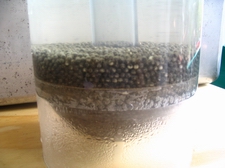Sturgeon Revival Program At Work in Vanderhoof
By Jan Baker

A team works at releasing an 80 year-old female White Sturgeon back into the Nechako River in Vanderhoof.
A large crowd of Vanderhoof community members and local schools were on hand to get a look at the impressive 220 pound, 7 foot long fish as a team prepared to return her to the Nechako river. Four males and another female were released earlier in the day.
All six fish had been picked up about ten days ago as part of the Nechako White Sturgeon Recovery Initiative. The team was able to milk and fertilize 150,000 White Sturgeon eggs in its Pilot Hatchery facility in Vanderhoof.
The eggs will take approximately one week to hatch. One week after that, the hatchlings will be ready to feed on commercial trout food. By the end of September or early October the white sturgeon will have grown to about 30 grams and 19 – 22 cm in length. They will each by ID tagged and then released at various times and places along the Nechako River. The fish will be tracked to determine which release dates and places were most successful.
It is expected that half of the fertilized eggs will die before hatching, and half of the survivors will die during the first week of feeding. Of those that survive until fall, 5,000 will be released into the Nechako River, while the others will be used for research.

Depending on river conditions, it will take around 20 years for the females to mature and be ready to spawn, and around 40 years for the males to mature and be ready to fertilize eggs.
Water temperature plays a large part in how fast the fish will grow and mature. In water temperatures below 10C the fish maintain their weight, but do not grow. In temperatures above 20C the risk of disease increases.
The Nechako White Sturgeon is listed as critically imperiled by the BC Conservation Data Centre. In 2005 there were fewer than 600 left, down from 5000 fifty years ago. The majority of these are 30 years-old or older. It is not known why there are no new White Sturgeon, but low water flows and water temperature are believed to be having a negative impact on spawning.
Previous Story - Next Story
Return to Home










I know, we are just being tested to see whether we actually read this.
;-)